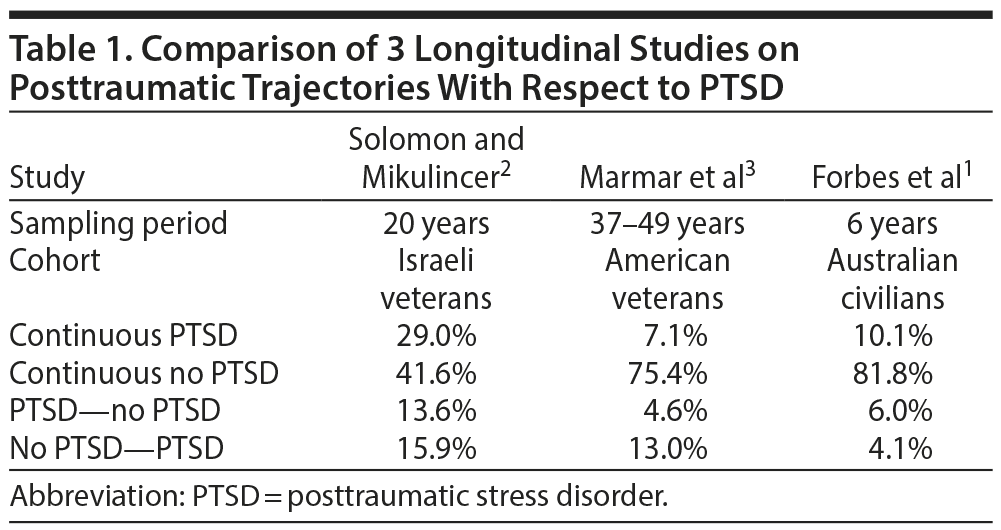Because this piece does not have an abstract, we have provided for your benefit the first 3 sentences of the full text.
There is very little information on long-term posttraumatic trajectories to inform clinical treatment and public health policy. Most longitudinal studies are limited to 2- to 3-year follow-ups. The study by Forbes and colleagues is a major addition to this important literature.
See article by Forbes et al
This work may not be copied, distributed, displayed, published, reproduced, transmitted, modified, posted, sold, licensed, or used for commercial purposes. By downloading this file, you are agreeing to the publisher’s Terms & Conditions.

There is very little information on long-term posttraumatic trajectories to inform clinical treatment and public health policy. Most longitudinal studies are limited to 2- to 3-year follow-ups. The study by Forbes and colleagues1 is a major addition to this important literature.
Until recently, Solomon and Mikulincer’s 2 20-year follow-up of Israeli Defense Force (IDF) veterans of the 1982 Lebanon War stood alone as the best longitudinal study of posttraumatic psychiatric trajectories. The study itself was a heroic achievement because the 2 principal investigators obtained their diagnostic and psychometric assessments in the war zone, near the Lebanon border, while the battles raged, in order to determine whether IDF combatants exhibited acute posttraumatic combat stress reactions (CSR). More importantly, for purposes of the present discussion, the investigators were able to assess posttraumatic stress disorder (PTSD) at 1, 2, 3, and 20 years in 214 of the original cohort (131 with and 83 without CSR) to provide a remarkable long-term perspective. Three major conclusions from this study were (1) individuals with severe acute posttraumatic reactions, CSR, were much more likely to exhibit PTSD 20 years later, than those without; (2) 13.6% of IDF veterans (with or without CSR) exhibited chronic PTSD 20 years later; and (3) there was considerable migration from PTSD to no PTSD status, and vice versa, at the 1-, 2-, 3-, and 20-year assessment points. Among IDF troops with PTSD at 1 year, 13.6% had no PTSD 20 years later, whereas 15.9% of those with no PTSD at 1 year had PTSD at 20 years. On the other hand, 29.0% of IDF veterans had PTSD throughout the 20-year study in contrast to 41.6% who never had the disorder.
The National Vietnam Veterans Readjustment Study (NVVRS) surveyed 1,632 combat veterans between 1986-1988 (as well as 716 era veterans). For veterans assessed in NVVRS, 11-22 years had passed since they were exposed to war-zone trauma. Current and lifetime PTSD prevalence for men was 15.2% and 30.9%, respectively, and 8.5% and 26.9% for female veterans.4 A more conservative estimate set prevalence at 9% and 19%, respectively, for veterans.5 Very recently, preliminary results of the National Vietnam Veterans Lifetime Study (NVVLS)3 were reported at the August 2014 annual meeting of the American Psychological Association. The trajectory for this study is even longer although there are only 2 assessment points for American veterans who served in Vietnam between 1964-1975. The NVVLS surveyed 1,450 veterans who participated in NVVRS. Data were collected between 2012-2013, so the follow-up was 37-49 years after war-zone exposure. Estimated current prevalence of war-related PTSD was 11.2%, while estimated prevalence of any PTSD (due to any traumatic event) was 12.2%. When a structured interview, rather than a standardized questionnaire, was used, current and lifetime prevalence fell to 4.5% and 17.0%, respectively. As for migration, 4.6% changed from PTSD to no PTSD; 13% changed from no PTSD to PTSD; 7.0% exhibited PTSD at both time points; and 75.4% never exhibited PTSD.3
Finally, Forbes et al1 now add to this sparse but critical literature with a 6-year longitudinal study of 987 civilian Australians whose traumatic experiences were severe enough to require immediate hospitalization for their injuries, including mild traumatic brain injury. Assessments were performed at 3, 12, and 72 months. The vast majority, 81.8%, never exhibited PTSD; 10.1% exhibited PTSD at all 3 assessment points; and the rest showed different trajectories. I have compared results from these 3 studies in Table 1; however, it is important to recognize that in order to be comparable to the Israeli and NVVLS data, I have only included participants in the Australian study who had either No Disorder or PTSD/Depression at the 3-month assessment. Participants in both the Alcohol and Alcohol/Depression classes were completely excluded. Because of important differences in methodology, sampling intervals, cohort characteristics, traumatic experiences, assessment strategy, data analysis, etc, it is not useful to undertake a fine-grained comparison between these 3 studies. The bottom line is that most trauma-exposed people are resilient and do not ever exhibit PTSD; others develop and later recover from PTSD; others develop delayed-onset PTSD; and a fourth group, a significant minority, suffer from PTSD that may persist for many years, if not decades. These findings have also been observed by other investigators with regard to survivors of the 9/11 World Trade Center attacks6; Israeli emergency room patients7; and elderly hurricane survivors.8
What is distinctive about the Australian study1 is its comprehensive and precise information on posttraumatic trajectories, with respect both to non-PTSD outcomes and, perhaps most interestingly, to the high level of migration across diagnostic classes as assessed at 3, 12, and 72 months.
As for outcomes, it is generally recognized that there are a number of clinically significant posttraumatic outcomes besides PTSD. Forbes and associates1 elegantly assess such outcomes and identify 4 latent classes that account for most diagnoses (Alcohol/Depression, Alcohol, PTSD/Depression, and No Disorder). Frankly, I was surprised at the prominence of alcoholism in this mix, probably because it has received so little attention by itself (except as a diagnosis comorbid with PTSD) in the trauma literature. Furthermore, whereas PTSD incidence decreased between 3 and 72 months (9.4%-7.7%), alcohol abuse and alcohol dependence increased (5.5%-8.0% and 3.5%-5.7%, respectively). These same findings are shown in the latent class analysis; PTSD/Depression decreased (10.3%-6.5%), whereas Alcohol increased (3.3%-5.4%).
The elegance of the Forbes et al study1 lies in the power of its longitudinal design, without which we could not appreciate the extent of migration from 1 class to the next. The likelihood that people with No Disorder at 3 or 12 months remain disorder-free at 72 months is very high. On the other hand, the same cannot be said for individuals who initially fell into any of the 3 clinical latent classes. Indeed, the stability of all 3 disorder classes is poor at 12 months. For example, less than half of individuals with PTSD/Depression at 12 months remained in that latent class since more than half achieved remission and entered the No Disorder class. Furthermore, 84.6% and 94.2% of the Alcohol/Depression and Alcohol classes, respectively, at 12 months, transitioned to a different class at 72 months (usually PTSD/Depression or No Disorder). On the other hand, the increase in the Alcohol class at 72 months is mostly due to people who transitioned from the No Disorder class.
There are several conclusions to draw from these findings, all of which have important implications. First, the vast majority of individuals will exhibit No Disorder at 3 months and remain disorder-free for at least 6 years. However, some people who are disorder-free at 3 months will have subsequent delayed onset of clinical disorder. In this study such migration was toward either Alcohol or PTSD/Depression. Therefore, as the authors1 suggest, “ongoing monitoring and preventive interventions” are indicated. In practice, such strategies would include education at both the clinical and public health levels so that self-monitoring or monitoring by family members could be carried out consistently and effectively. This would be especially true following mass casualties or disasters within the civilian domain and following military deployments for service members and veterans.
Second, it is not all about PTSD. Depression and alcohol-related outcomes deserve major attention in their own right, not simply as disorders that are comorbid with PTSD. This has obvious implications for office-based clinical follow-up as well as public health surveillance following exposure to traumatic events.
Third, a longitudinal perspective is essential with respect to both chronicity and delayed onset of clinically significant disorder.
Fourth, clinical needs may shift over time because of migration from 1 disorder class to another. For example, people who need PTSD treatment at one point may require attention for their alcoholism at another point. A real challenge in the future will be to identify predictors of stability or migration with respect to Disorder and No Disorder classes.
Finally, transdiagnostic approaches9 may be much more useful than diagnosis-specific treatments since the authors were able to encompass 9 PTSD/mood/anxiety/alcohol-related disorders into 3 clinically significant latent classes. Such a transdiagnostic approach may have great utility within both clinical and public health arenas.
The cohort of Forbes and colleagues is extremely valuable, and the authors are to be congratulated for carrying out such a challenging prospective study. I hope that the authors will continue to follow this cohort as long as possible. The current results should have an impact on both clinical programs and public health policy. If this cohort can be sustained for additional assessments at future time points, such results will undoubtedly enrich our understanding of the complexity of posttraumatic trajectories and thereby help us make evidence-based decisions regarding prevention and treatment for individuals exposed to traumatic events.
Submitted: September 2, 2014; accepted September 3, 2014.
Potential conflicts of interest: None reported.
Funding/support: None reported.
Disclaimer: The opinions expressed are entirely my own and neither those of the US Department of Veterans Affairs nor those of the National Center for PTSD.
REFERENCES
1. Forbes D, Nickerson A, Alkemade N, et al. Longitudinal analysis of latent classes of psychopathology and patterns of class migration in survivors of severe injury. J Clin Psychiatry. 2015;76(9):1193-1199.
2. Solomon Z, Mikulincer M. Trajectories of PTSD: a 20-year longitudinal study. Am J Psychiatry. 2006;163(4):659-666. PubMed doi:10.1176/appi.ajp.163.4.659
3. Marmar CR, Schlenga W, Henn-Haase C, et al. Prevalence and Course of Posttraumatic Stress Disorder: Preliminary findings. Presented at Annual Meeting, American Psychological Association, Washington, DC, August 7-10, 2014.
4. Schlenger WE, Kulka RA, Fairbank JA, et al. The prevalence of post-traumatic stress disorder in the Vietnam generation: a multimethod, multisource assessment of psychiatric disorder. J Trauma Stress. 1992;5(3):333-363. doi:10.1002/jts.2490050303
5. Dohrenwend BP, Turner JB, Turse NA, et al. The psychological risks of Vietnam for US veterans: a revisit with new data and methods. Science. 2006;313(5789):979-982. PubMed doi:10.1126/science.1128944
6. DiGrande L, Neria Y, Brackbill RM, et al. Long-term posttraumatic stress symptoms among 3,271 civilian survivors of the September 11, 2001, terrorist attacks on the World Trade Center. Am J Epidemiol. 2011;173(3):271-281. PubMed doi:10.1093/aje/kwq372
7. Galatzer-Levy IR, Ankri Y, Freedman S, et al. Early PTSD symptom trajectories: persistence, recovery, and response to treatment: results from the Jerusalem Trauma Outreach and Prevention Study (J-TOPS). PLoS ONE. 2013;8(8):e70084. PubMed doi:10.1371/journal.pone.0070084
8. Pietrzak RH, Van Ness PH, Fried TR, et al. Trajectories of posttraumatic stress symptomatology in older persons affected by a large-magnitude disaster. J Psychiatr Res. 2013;47(4):520-526. PubMed doi:10.1016/j.jpsychires.2012.12.005
9. Barlow DH, Farchione TJ, Fairholme CP, et al. Unified Protocol for Transdiagnostic Treatment of Emotional Disorders: Therapist Guide (treatments that work). Oxford, UK: Oxford University Press; 2010.
aNational Center for PTSD, US Department of Veterans Affairs, White River Junction, Vermont, Departments of Psychiatry and Pharmacology & Toxicology, Geisel School of Medicine at Dartmouth, Hanover, New Hampshire.
*Corresponding author: Matthew J. Friedman MD, PhD, National Center for PTSD, VA Medical Center, 215 North Main St, White River Junction, VT 05009 ([email protected]).
J Clin Psychiatry 2015;76(9):e1153-e1154
dx.doi.org/10.4088/JCP.14com09488
© Copyright 2015 Physicians Postgraduate Press, Inc.
This PDF is free for all visitors!
Save
Cite




